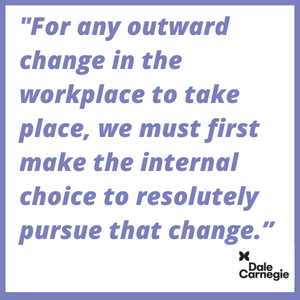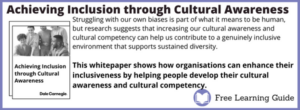
Whilst women have made great strides in the workplace in the last few decades, evidence indicates that the gender pay gap still exists and that for women in some industries there is still a glass ceiling. With so much discussion now around diversity and inclusivity in the workplace, we know there is a strong business case to be made for promoting an inclusive culture as it positively impacts the bottom line for an organisation. When considering women at work and creating an inclusive culture, this does not mean that the conversation takes place without men; so, is there a way we can make the workplace an equitable environment? And how can males better support women in the workplace? Let’s examine the role that allyship has in leveraging female leadership.
Understanding allyship
Allyship is a term that exists in spaces where it is acknowledged that a group of individuals is marginalised. The purpose of allyship is to show support for that group from individuals that are not members of that group. For the context of this article, we will examine how men can be part of creating an inclusive culture in the workplace for women. For a man to be an ally in the workplace he must speak up in support of gender equality and recognise his own privilege. This can manifest in anything from leadership roles or higher salaries. It’s about showing in their behaviour efforts to address gender inequalities in the workplace and becoming a “catalyst for change, challenging organisational structures that disadvantage women while remaining committed to the success of the organisation”.
Do women need male allies?
Whilst change is slowly taking place within the workplace, it is not realistic to believe this can be effected without everybody on board. Women’s groups have acknowledged this and are increasingly involving men in their conversations and conferences. There is evidence that focusing on gender initiatives and trying to change women either through the way that they lead or other efforts to alter their behaviour is wrong.
Inclusivity and allyship in action
Recognition is only the first step toward creating an inclusive culture. Making the decision that change is needed then must be put into a practical plan of action. “For any outward change in the workplace to take place, we must first make the internal choice to resolutely pursue that change.” Once that choice is made it is important to reflect on our differences and think about how we can relate to co-workers, in this instance men and women. When men actively pursue a path of raising awareness and engaging in conversations, men can start to understand their own privilege and opportunities and consider how they can become allies, and open the door to the same opportunities for female co-workers. This is not an easy process as inevitably it may unearth unconscious bias and potentially uncomfortable conversations around the gender pay gap.
Creating an equitable environment requires transparency in communication, being honest with ourselves and others, creating a deeper level of trust, and maintaining a mutual level of respect for the other person. Sometimes these uncomfortable conversations need to happen for there to be personal growth and to make much needed progress.
What are the practical steps to take in shifting behaviour?
– Create a psychologically safe environment
Without this as part of a business culture, it will be impossible to start conversations around how allyship can contribute to an inclusive culture.
– Implement shifts in historical behaviour
This means firstly acknowledging negative behaviours that have existed, then holding discussions about the best way to move past this behaviour.
– Educate people in business
A massive part of creating an inclusive culture is to raise awareness, show where differences and privilege exist and how that impacts historically underrepresented groups.
– Actively participate in shifting culture
The leadership team tend to steer changes in culture but allyship is also about individuals being mindful about what they can do to shift culture.
How can men demonstrate allyship?
This is both the responsibility of the business but also individual men making small changes in their behaviour that contribute to a catalyst for change. Whilst it is about being active allies, an interesting way to have an impact is in fact by doing less:
- Step aside for female colleagues
Organisations such as the UN Global Compact have made the decision not to participate in all-male panels. The “pass up and pass on “strategy may seem small but is effective. Another way this could be exemplified is by passing up a project and recommending a female colleague to take it on. - Sharing workload
There is a tendency in an environment such as a meeting when small tasks are dished out that women will tend to volunteer for the non-promotable tasks. If more men volunteered to do these perceived lesser tasks, it would enable women to take on the higher profile work and seize opportunities for success. - Pay gap
Whilst conversations around wages can be awkward, there are some notable examples where men have advocated for their female counterparts. There have been publicised examples of allyship in Hollywood with high-profile actors such as Benedict Cumberbatch making a commitment to only take on projects where his female co-workers are on equal pay. Public statements such as this send a powerful message to the establishment that it’s time for a change.
An organisational culture that does not make talented, diverse employees feel valued and supported is certain to lose them, increasing the cost of turnover and lowering morale and productivity.
Inclusive workplaces recognise that there is no stereotypical person who is best for the job. Instead, the people around them can identify the individual who has the right talent to perform the role best. In an inclusive workplace, teams celebrate these talents and do not see each other as a threat to their own role. People support each other, listen to each other and those in positions of influence use it to recognise and advocate for others to be treated fairly.
The role that allyship plays in bringing about a workplace that has built an inclusive culture is critical. Men can play a huge part in creating an equitable environment and helping to close the gender pay gap and shatter glass ceilings.




